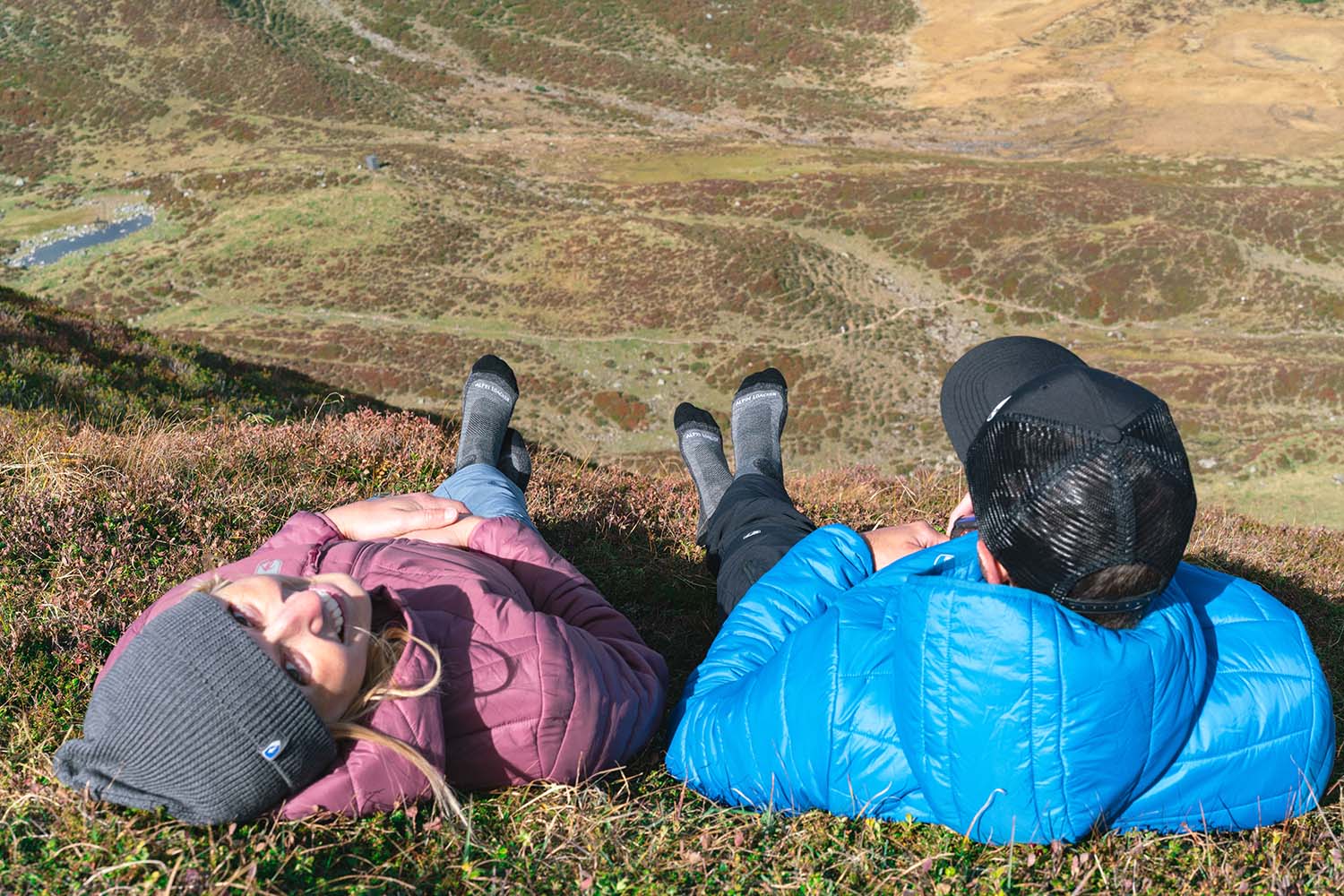Merino wool is indispensable for outdoor enthusiasts: it regulates temperature and moisture, feels pleasant on the skin and remains odorless even after repeated wear.
However, holes can be caused by moths, care errors or abrasion. To avoid this, it is advisable to gently clean merino clothing with a suitable detergent and put it away if it is subject to heavy wear.
Lavender, cedar wood and sealed storage help against moths.
And if it does happen - repair it instead of disposing of it.
Table of contents
- 1. why merino wool?
- 2. how to wash merino?
- 3. abrasion and wear
- 4. repair instead of throwing away
- 5. how you can avoid mechanical damage
- 6. prevent moth infestation
1. why merino wool?
Merino wool is a particularly high-quality material obtained from the fine skins of Merino sheep.
It has many outstanding properties that make it a preferred choice for clothing and textiles.
Here are some reasons why merino wool is so highly valued:
Breathability and moisture management: Merino wool is able to absorb and wick moisture away from the skin while regulating body temperature. It keeps the body warm in cold weather by retaining heat and at the same time provides a pleasant cooling effect in warmer temperatures.
Softness and comfort: Merino wool is much finer and softer than normal new wool, which makes it particularly pleasant on the skin. It does not itch and is therefore also suitable for sensitive skin.
Odor-inhibiting: Merino wool has naturally antibacterial properties that help to prevent unpleasant odors. This makes it an excellent choice for clothing that is worn for longer periods of time, such as functional clothing, sportswear or travel outfits.
Sustainability: Merino wool is a natural, renewable material. Sheep are shorn regularly without affecting their well-being. Merino wool is also biodegradable and therefore has a lower environmental impact than synthetic fibers.
Durability: Merino wool is extremely hard-wearing and retains its shape and properties even after frequent washing. It is resistant to pilling (the felting of fibers), which extends the life of clothing.
Versatility: Merino wool is suitable for a wide range of garments, from fine sweaters and T-shirts to robust outdoor clothing. It can be worn all year round as it is both insulating and breathable.
Easy care: Merino wool is easier to care for than conventional wool. Many merino products can be machine washed on the wool cycle, which minimizes the amount of care required.
In summary: Merino wool is one of the best choices for high-quality, comfortable and durable clothing due to its natural properties such as softness, breathability, sustainability and ease of care.

2. how to wash merino?
Merino wool is delicate and requires special care to maintain its quality and longevity.
Although hand washing is ideal, merino items can also be washed at 30-40°C on a wool cycle and with a special wool detergent - it is important that the detergent does not contain any enzymes or fabric softeners, as these damage the fibers.
Bleach and tumble dryers are also taboo.
To avoid felting and holes, merino wool should not be wrung out and is better dried lying flat rather than hanging.
A laundry bag can provide additional protection.
3. abrasion and wear
Merino wool has many advantages, but it is sensitive to abrasion and wear. The fine fibers are less tear-resistant and can wear out more quickly, especially when worn under a backpack.
Pilling - small knots or fluff caused by friction - can also often be observed. Although this does not impair the function, it can be visually distracting.
To minimize wear and tear, it is advisable to avoid rubbing as much as possible and to carefully care for the material with a lint roller or a special shaver if necessary.
Expert tip: Linting can be prevented by occasionally putting merino products in the washing machine together with rougher products (e.g. denim garments).

4. repair instead of throwing away
If your favorite merino items suddenly show small holes after storage or washing, the causes could be not only moth infestation, but also care errors.
After thorough cleaning, there is only one thing to do: darn the holes!
If you can do it yourself, you will need a needle, thread and a little patience.
If not, you can go to a tailor or learn how to do it with the help of online tutorials. Mending is not only a practical skill, but also a sustainable way to continue using long-lasting merino items - a good choice for the environment and your wallet.
5. prevent moth infestation
To prevent moth infestation on your merino clothing, we recommend the following precautions:
Storage:Store your merino clothing in a cool, dry room. Make sure the room is well ventilated as moths prefer humid environments.
Airtight storage: Use airtight containers or special garment bags to protect your clothes from moths. This is especially important during the transitional period when you store your winter clothes.
Air your clothes regularly: Hang your clothes up to air occasionally, especially in the warmer months, to prevent mildew and moth infestation.
Natural repellents: Use natural moth repellents such as lavender, cedarwood or essential oils (e.g. eucalyptus or tea tree oil), which give off an unpleasant odor to moths without harming your clothes.
Dry cleaning: Wash or dry clean your merino clothing regularly. Moths are often attracted to dirt or skin particles that become trapped in the fibers.
Inspection: Regularly check your clothing for signs of moth infestation, such as small holes or a chewed structure of the fibers. By following these tips, you can protect your merino clothing in the long term and ensure that it remains in perfect condition.

6 How to avoid mechanical damage
Although merino wool is incredibly soft and comfortable, it is also more sensitive than many other materials due to its fine fibers.
A simple rule is particularly effective for everyday use: where nothing rubs, there is no abrasion. To protect your merino items, avoid direct contact with rucksack straps or rough surfaces. This will keep your merino clothing beautiful and intact for a long time.











